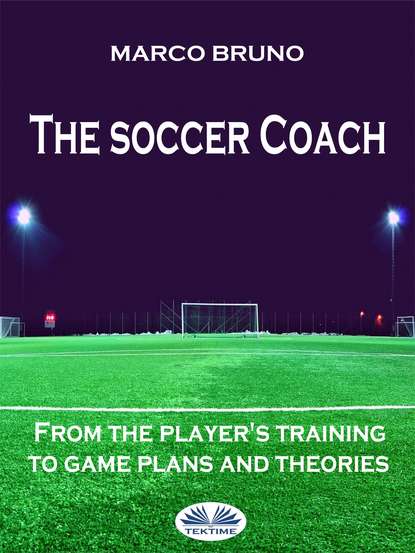По всем вопросам обращайтесь на: info@litportal.ru
(©) 2003-2024.
✖
The Soccer Coach
Настройки чтения
Размер шрифта
Высота строк
Поля
max HR = 205-(age divided by 2) for men
or Karvonen’s formula: max HR = 220 – resting frequency
or better yet, Tanaka's formula: max HR = 208 - (0,7 times age)
We must remember that:
- between 50-60% of max HR, a moderate work is carried out;
- between 60-70% of max HR, a great work is carried out (also called cardio-training);
- between 70-80% of max HR, an aerobic sub-maximal work is carried out close to the limit;
- between 80-90% of max HR, a maximal anaerobic work is carried out;
- over 90% is achieved a maximum work (not recommended).
From the duration point of view, the effort can be:
short or long;
continuous or variable;
with or without interruption.
From the complexity point of view, the effort can be:
simple (e.g. marathon);
complex (e.g. soccer).
From the point of view of metabolic processes of energy production, the effort can be:
aerobic;
anaerobic;
mixed.
For soccer, the specific effort is considered:
For intensity:
- sub-maximal (heart rate180/200 - resp. rate30/40)
For duration:
- variable with numerous interruptions
For complexity:
- complex since it uses different physical qualities (speed, force, etc.), technical actions, tactics, with situations of physical confrontation.
For metabolic processes:
- mixed, with considerable anaerobic alactacid commitment
The third operation is to establish the growth and the decrease of the efforts during the training
Basically, to establish the training plan and the physical training program.
The central objective of all soccer training must be to improve the operational capabilities of the player. (Bisanz-Gerisch, 1990). This statement serves to reduce the importance of condition factors to avoid overestimation and excessive undervaluation in training. In targeted soccer training we will try to encourage an exercise of speed of action that is oriented to the practice of the game always taking into account all the mental, physical, technical, tactical and social performance factors. The following quotes show that a specific theory of soccer training must be based on the demands of the competition and that the training of the condition must be assimilated to the practice of the game or possibly be integrated with it.
“The best teacher for training is the competition” (Cramer, 1987).
“From the competition we understand what we have to train” (Krauspe-Rauhut-Teschner, 1990).
“If the competition is the best training, it is also true that a good workout must necessarily have the nature of a competition” (Northpoth, 1988).
“The secret of soccer is always in the training session” (Beenhakker, 1990).
“The central objective of every soccer training must be to improve the player’s ability to act” (Bisanz-Gerisch, 1990).
From these quotes it appears that the soccer training of the condition must be assimilated to the practice of the game or possibly be integrated with it. Therefore training is not an end in itself but it follows the objective of “improving the ability to play and to optimize the ability to act”.
If on the one hand we want to reduce the importance of the factors of physical condition, on the other hand it will be appropriate to encourage in soccer training an exercise of speed of action that orients the practice of the game keeping in mind all the factors of performance at a technical-tactical and psycho-social level. This means that it is necessary to give more importance to training close to the practice of the game with more and more specialized methods and means. (Lottermann, 1990).
TRAINING OF YOUNG PLAYERS
It is opportune to dwell first on the most serious errors that are committed with regard to the goals of youth training.
The first mistake is to relate the young to a reduced image of the adult without considering that he has a personality still in training, ways of thinking still evolving and above all completely different physique and abilities. Adult training cannot be transferred to the youth sphere, perhaps only by paying attention to reducing the quantity and intensity.
The increase in physical capacity cannot be proposed in the same way for young people and adults, indeed there must be further differentiation even in the same youth field, according to age groups.
Lead, for example, a cycle of training for 12-13 year olds (very young) with the aim of achieving maximum performance to achieve immediate successes; it means distorting the spirit of training itself; in fact, the boy must be led gradually and in small steps and over the years towards the desired return.
A preparation too fast and early, which is usually always linked to achieving ambitious goals for adults, will give significant results in the short run, but it certainly causes damage that almost always are irreversible.
When young people and adolescents in particular are subjected to an excessive physical and psychological burden, their motivation for what they are doing decreases; their desire diminishes until they reach a real refusal in the face of the first failures. So you can understand how many times the young players after training with their team, find themselves (in the oratory, in the yard or in open spaces) to finally play soccer.
A graded and targeted workout leads to a higher degree of physical and athletic preparation in adulthood and keeps it stable longer over time.
At the end of the youth cycle the player must:
have reached a correct physical maturation;
have acquired a complete technical background;





